Unexpected Vietnam
From UNESCO World Heritage Sites to an amusement park, delightful surprises await in central Vietnam
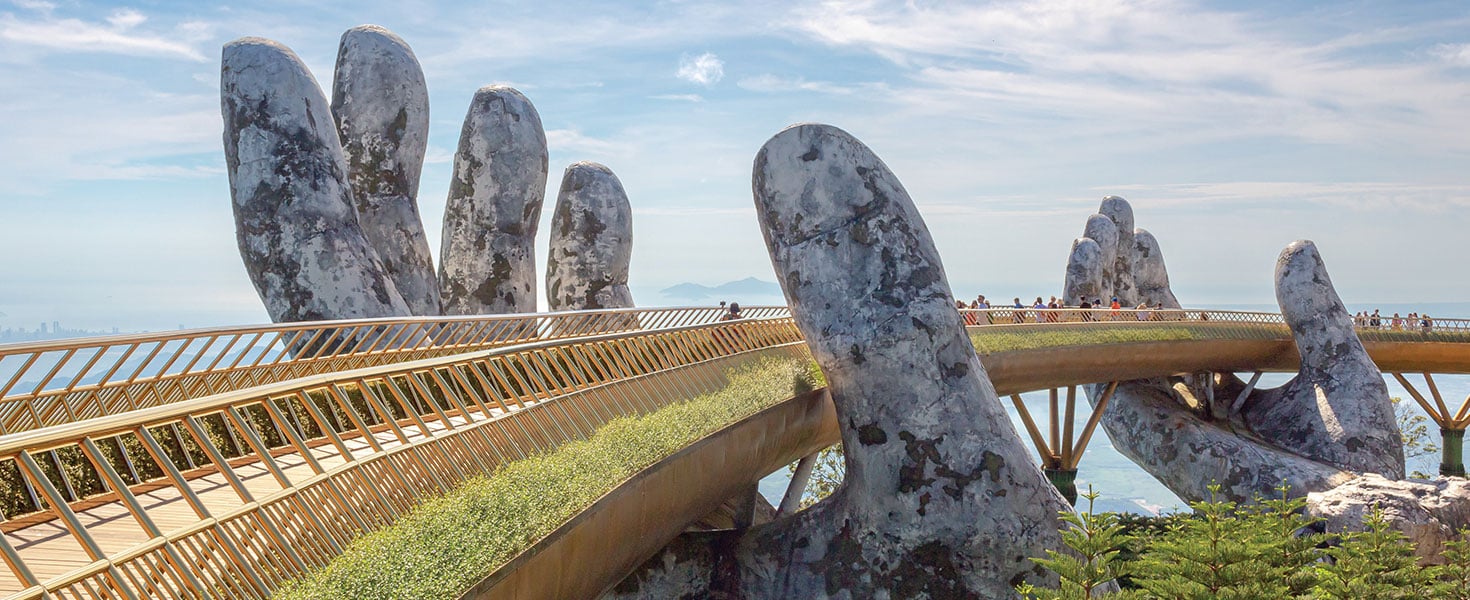
Just past dawn in the jungle-cloaked mountains of Central Vietnam, fog slinked along hillsides and beams of sunlight struggled to pierce an uninhabited valley. The sound of a stream merged with morning birdcalls. When light began to fill the scene, a curtain lifted on My Son, a tidy collection of brick Hindu temples from the Champa Kingdom. There was nary another visitor in view, and for 20 minutes or so I wandered, privileged to have a UNESCO World Heritage Site to myself.
On my third visit to Central Vietnam, I found many such instances of time travel and secret places intermingling with abandon.
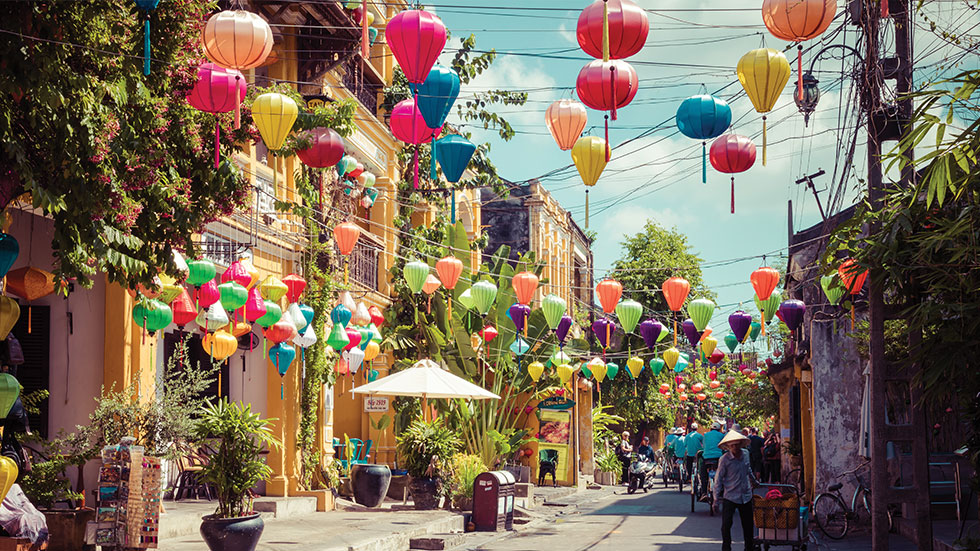
Car-free Hoi An is lined with restaurants, tailors and silk-lantern shops. Photo By Curioso.Photography/Stock.Adobe.Com
Hanoi in the north and Ho Chi Minh City (formerly Saigon) in the south are the usual points of entry for travelers coming to Vietnam. But those who overlook Central Vietnam miss out on some of the country’s iconic sights, its best beaches and a more relaxed pace than the big cities offer.
At My Son, I discovered both a distant relative to the much more famous (and expansive) Angkor Wat temple complex in Cambodia and a touchstone to the war the US still grapples with. Occupied for almost 1,000 years starting in the late 4th century, enigmatic My Son may have been Southeast Asia’s longest-inhabited religious center. A week of carpet-bombing in 1969 by US forces sundered most of the temples—signs warn of unexploded ordnance nearby—but a rebuilding program has been underway since UNESCO designation in 1999.

Mysterious Hindu ruins of My Son near Hoi An, a distant relative to the famed Angkor Wat in Cambodia. Photo By David Swanson
MAKING HISTORY IN HOI AN
If My Son was spooky and mysterious, nearby Hoi A was joyful and vibrant. Originally a Champa seaport, its charismatic merchant homes and streetscapes appear virtually unchanged from more than 200 year ago. Today, it’s alive and well-kempt with colorful lanterns bobbing overhead, the houses now used for restaurants, tailors and silk-lantern shops.
Hoi An was awarded UNESCO World Heritage status as “an exceptionally well-preserved example of a traditional Asian trading port.” It’s a time capsule that retains influences from Asian and European cultures, such as an 18th-century Japanese wooden bridge and pagoda.
Along the wharf are casual outdoor cafés with names like Mr. Rin or Mr. Soi, and on street corners, old women peddle cigarettes, lollypops and bananas, their teeth stained red from chewing betel leaf and areca nut.
The open-air market displays the bounty of Vietnam’s agriculture and farms, with dozens of vendors presenting tables of fresh fruits and vegetables, crates of eggs, caged chickens and baskets of nuts.
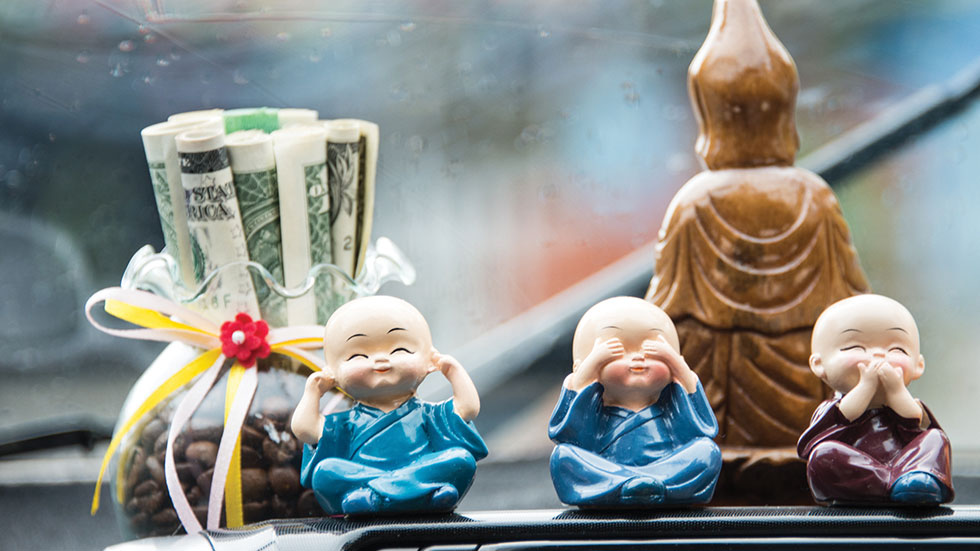
Dashboard offerings in a taxi en route to Hoi An. Photo by David Swanson
Food is celebrated everywhere in Vietnam, but especially here. Hoi An offers a seemingly endless array of dining options, from enticing street food to full-on gourmet meals served in lovingly maintained historic buildings.
Hoi An’s best-known chef is Trinh Diem Vy, whose business empire includes her most famous restaurant, Morning Glory, named for the deliciously bitter vine.
“It’s the only dish you can order anywhere in Vietnam, from the north to the south, stir-fried with garlic,” Vy told me. “Otherwise, the food of the north has more Chinese influence, and in the south, dishes are made with coconut cream.” Vy serves up the street food of her childhood: crispy pancakes made from a batter of mung beans and rice, banana flower salad, caramelized pork with peas and mushrooms—all delicious.
 Upriver from Hué, the Pagoda of the Celestial Lady. Photo By Sergii Figurnyistock.Adobe.Com
Upriver from Hué, the Pagoda of the Celestial Lady. Photo By Sergii Figurnyistock.Adobe.Com
MODERN DA NANG
I was lured back to Central Vietnam for my third visit to the country when my friend Ben decided to pursue a business opportunity in Da Nang. Although I had passed through Da Nang on my first Vietnam trip, the city I saw today bore no resemblance to that former self, except for the curious round basket boats known as thung-chai that fishermen use to ply the broad bay each morning.
In the 1960s, the city’s shoreline was nicknamed China Beach by American service members—a misnomer that I am assured is not well-received locally. Today, Da Nang is one of Vietnam’s largest cities, with a population of more than one million, its beach lined with high-rises and luxury resorts. Close to the sand, an improbable karst limestone outcrop called the Marble Mountains is riven with fairy-tale caves and Buddha and Hindu altars.
I met Ben and his girlfriend, Allison, for dinner at Bep Hen, a small restaurant in Da Nang with an invitingly retro environment that felt like some beloved uncle’s attic, with old TVs and furniture and French pop music from the 1960s. We enjoyed plate after plate of wildly flavorful food—fried tofu with minced pork, fried chicken in fish sauce, braised pork belly with duck egg, and Huda beer served with an ice cube.
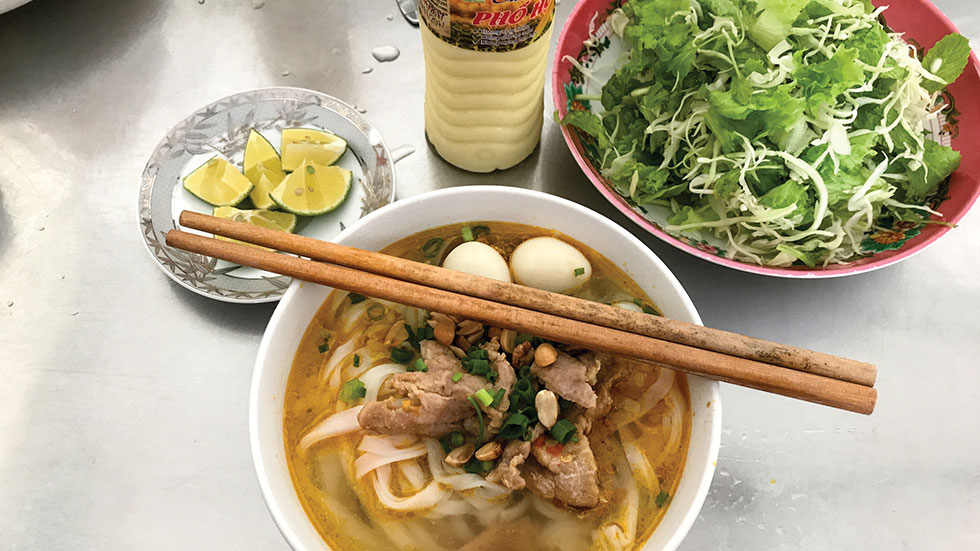
Mi quang, a staple of Central Vietnam, makes for a hearty breakfast. Photo by David Swanson
A newer attraction made me smile. Located in the hills above Da Nang, Ba Na Hills reinterprets a dollop of French colonial history, a collection of summer villas dating back to 1919, when Da Nang was a colonial port. Called Sun World today, the site has been developed into a pseudo-Disneyland, reached by the longest cable car route in the world, almost 30 minutes to the top. At the summit, ersatz chateaus are filled with resorts and restaurants. There are also amusement park rides, manicured gardens that invite strolling, and a bizarre wax museum stocked with celebrity lookalikes sporting awkward poses and expressions. There’s even the perfect Instagram spot: the Golden Bridge, a fantastical 490-foot footbridge supported by two enormous fiberglass hands.
Da Nang hums at a gentle pace, and as the city reinvents itself as the modern tech hub of Vietnam, it also offers a friendly, easy-going base for day trips to most of Central Vietnam’s prime attractions (Hoi An and My Son are less than an hour away). Yet to be discovered by most US visitors, it allows for a kind of truly Asian vacation—even if you stay, as I did, at the Sheraton Grand Da Nang Resort with its Western-style creature comforts.
From Da Nang, I hired a driver to take me north through the mountains, emerging into a bucolic landscape of flyspeck villages and rice paddies leading to Hué (pronounced hway), the sleepy city that served as Vietnam’s last dynastic capital. Located close to the former Demilitarized Zone that divided north and south during the war, it suffered heavy damage, particularly during the Tet Offensive, when most of the city and its imperial citadel were leveled.
On the banks of the Perfume River facing the citadel, a historic mansion managed to escape destruction. Built in 1930, at the peak of the Art Deco movement, the house was originally the French colonial governor’s residence. In 2005, it was redeveloped into a deluxe hotel, La Résidence, with a pair of new four-story wings. The original mansion oozes Art Deco swank, with terrazzo floors and teak armchairs in the fan-shaped Gouverneur Bar.
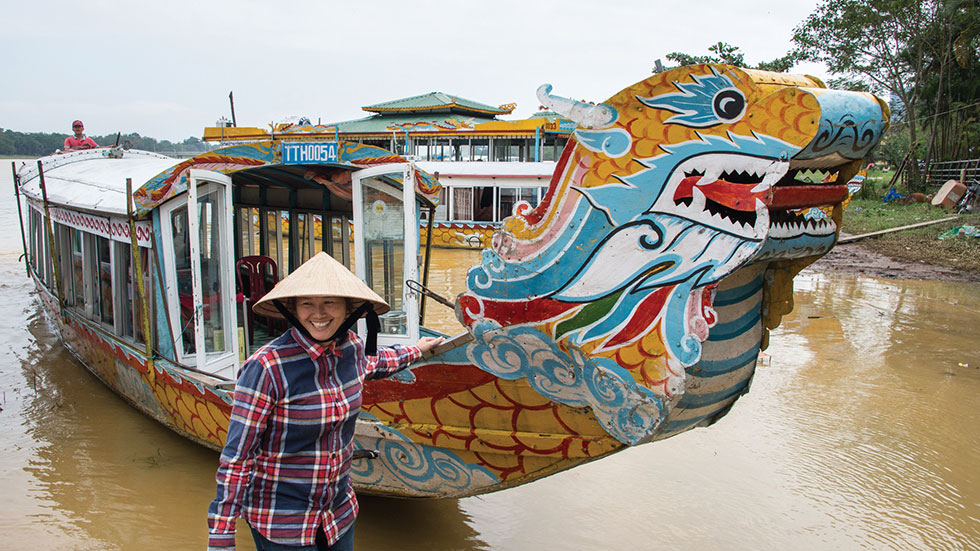
Dragon boats ply the Perfume River in Hué, offering cruises to the Royal Tombs. Photo David Swanson
I booked a private half-day tour of Hué’s major sights, boarding a dragon boat for a cruise up the river. Sampans put-putted near our first stop, Chùa Thiên Mu, or the Pagoda of the Celestial Lady, a delicate, octagonal tower rising seven stories from a hill next to the river. Framed by pine trees, the peaceful sanctuary is now a Buddhist school educating boys ranging from toddlers to teens, all scurrying about in brown robes.
My guide, Vân Anh, explained how, in 1601, a high-ranking Mandarin from the north came to Hué to cultivate the south and establish the Nguyen Dynasty, building the temple. When the north and south were unified in 1801, Hué became Vietnam’s capital.
Farther upriver, we visited the tomb of the second Nguyen emperor, one of seven ornate mausoleums dotting the countryside of Hué. Surrounded by forest, the serene 44-acre site is a series of terraces and lakes that leads through temples and courtyards and across bridges to a final staircase climbing a hill. At its end is a locked gate: the burial chamber hidden beneath the pine trees.
The centerpiece of Hué—and key to its UNESCO World Heritage designation—is the 19th-century Imperial City surrounded by miles of 6-foot-thick brick walls and a moat. Conceived with Beijing’s Forbidden City in mind, the citadel was built by more than 50,000 people starting in 1805. Some of the buildings within the Imperial City were destroyed by fire in 1947 (others crumbled during the Tet Offensive). Thai Hoa Palace, the Hall of Supreme Harmony, is one of several structures that have been gloriously restored. Originally used for the king’s most important ceremonies and open only to the royal family, the lavish palace is supported by 80 ironwood columns awash in red lacquer and emblazoned with dragons.
I returned that night for a meal at Les Jardins de la Carambole, a restaurant in another French colonial residence, wrapped by terraces and balconies and located just inside the walled citadel. Under circling fans and with a pianist playing unobtrusively, elegantly garnished plates of food emerged from the kitchen.
Lest I become too enmeshed in the reign of Hue’s Nguyen emperors, Les Jardins slyly submerged me in the Indochine era, the sometimes-sentimentalized mid-century period of French occupation that led to the war. Decorated with period antiques and pastoral paintings, the restaurant succeeded in transporting me to yet another time and world.
